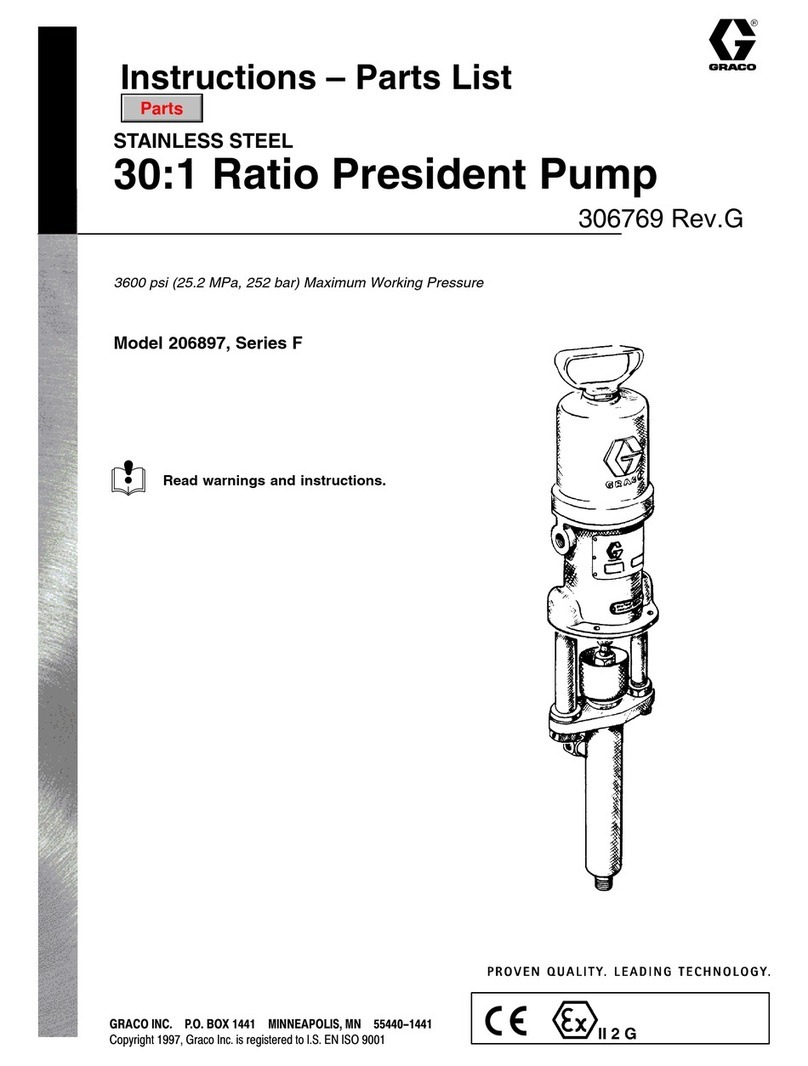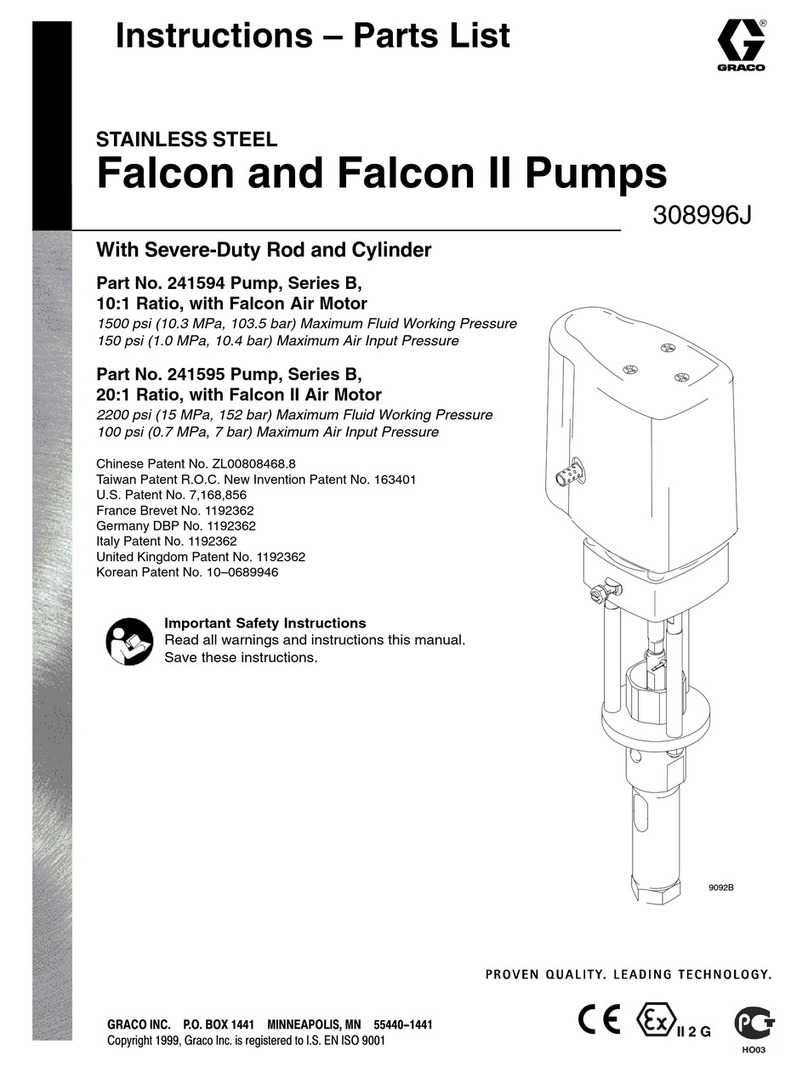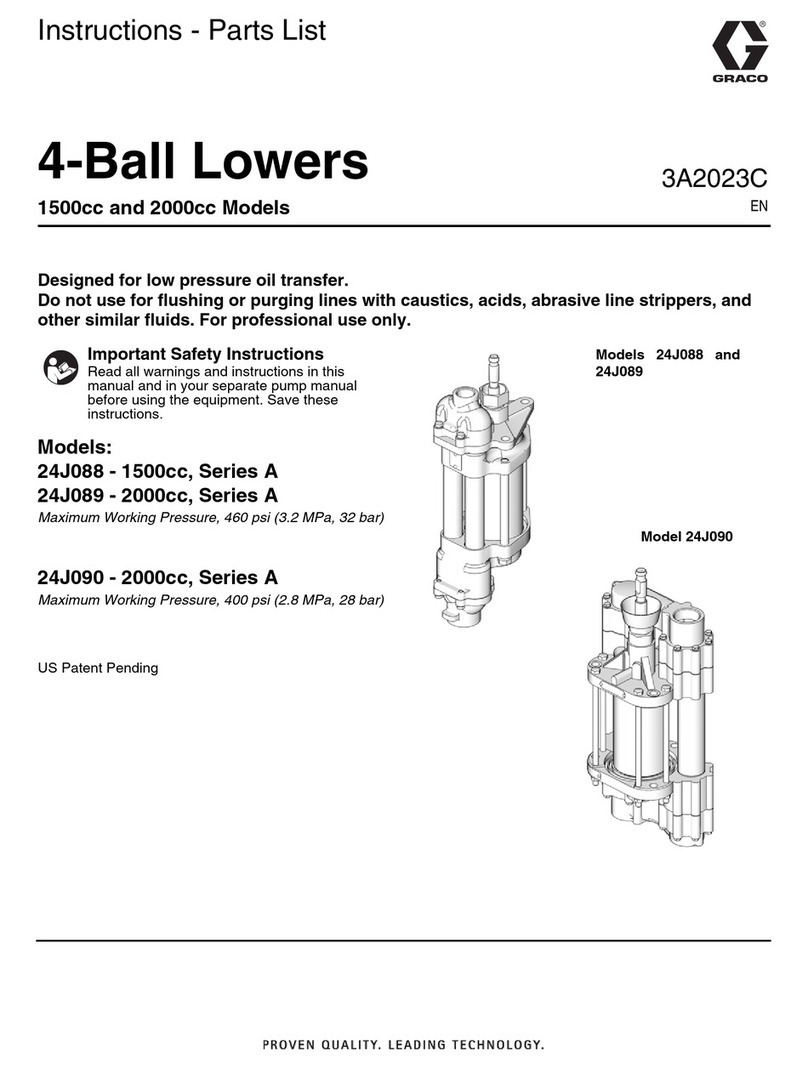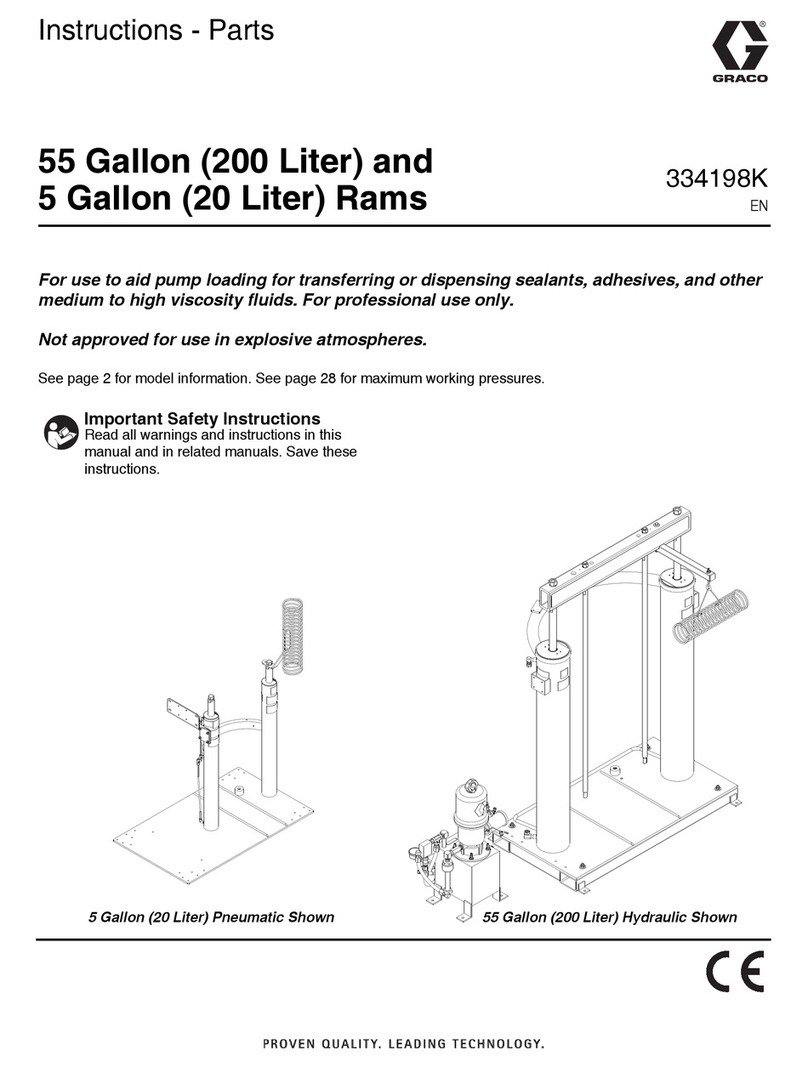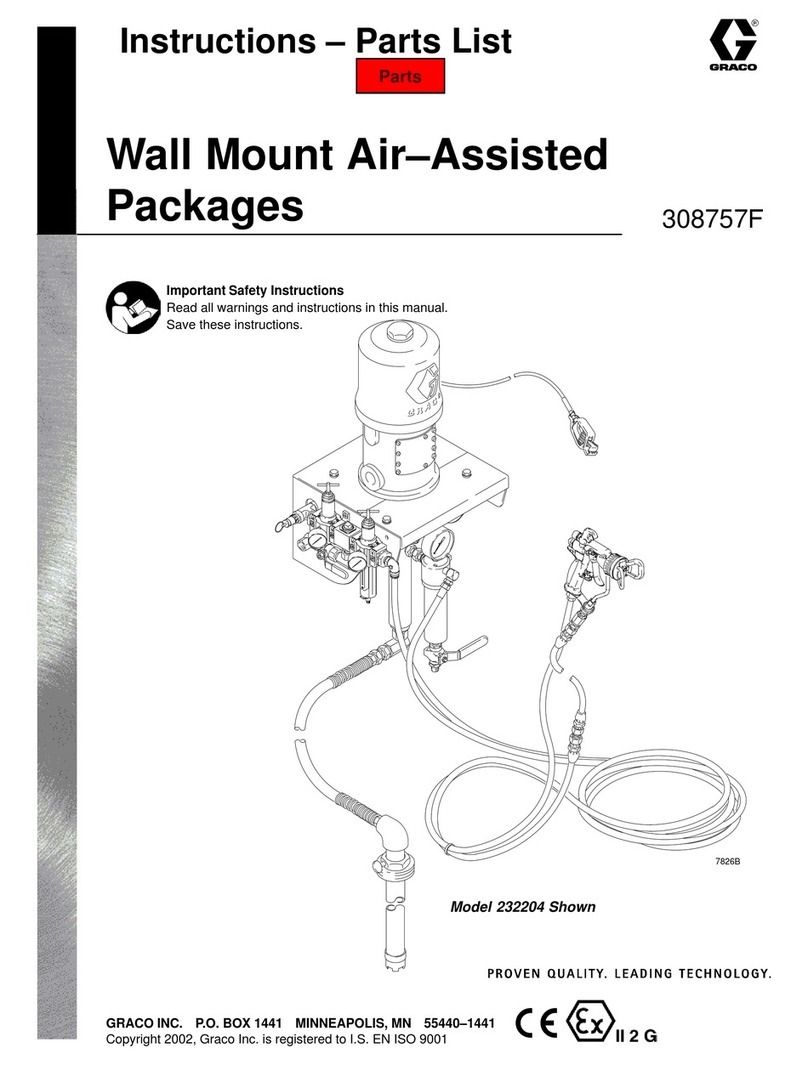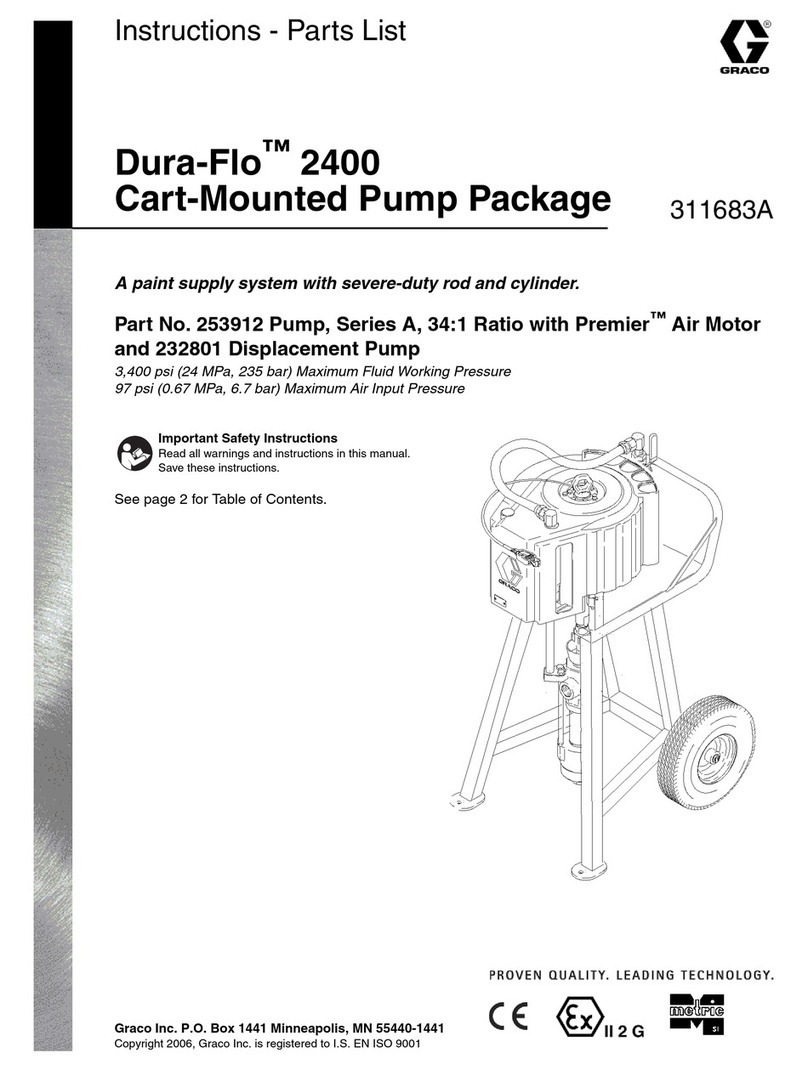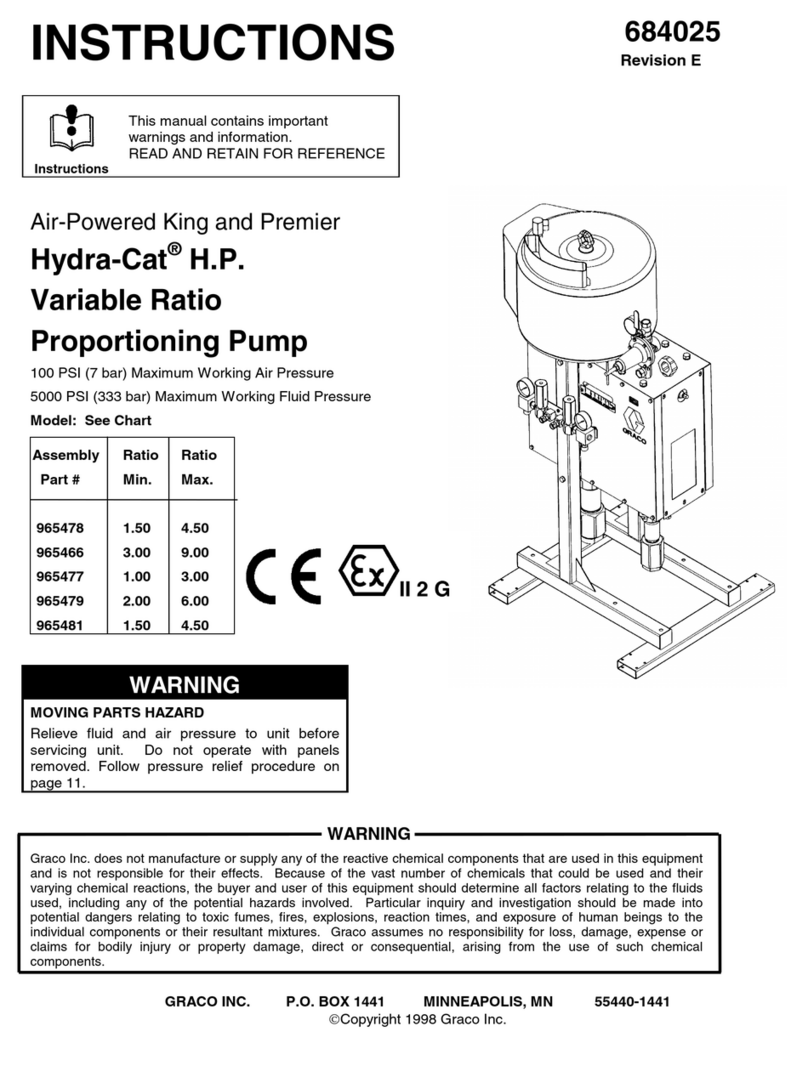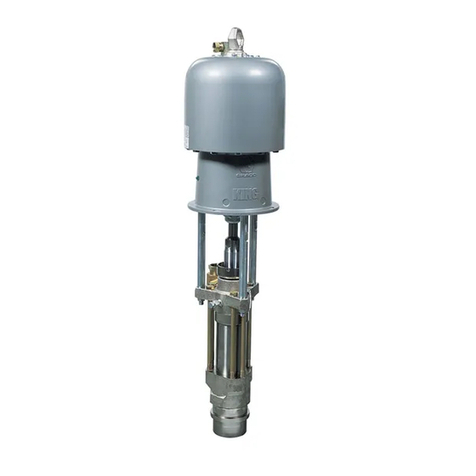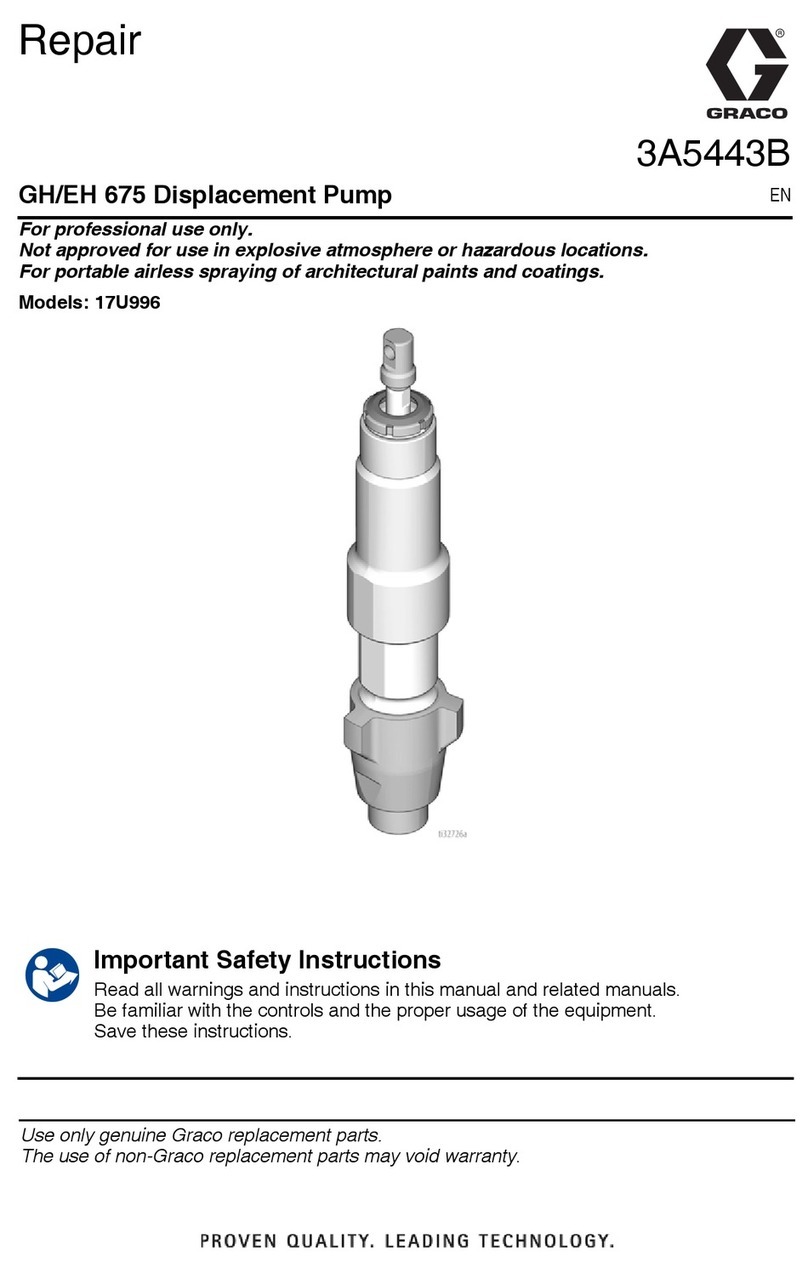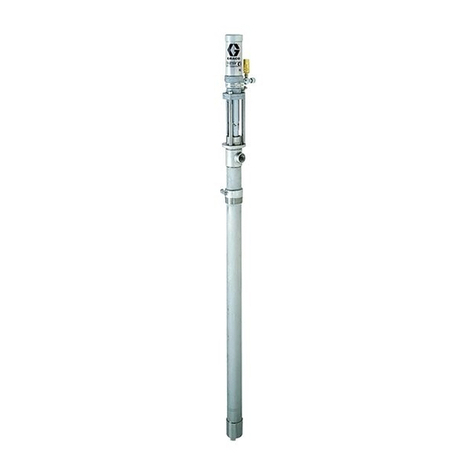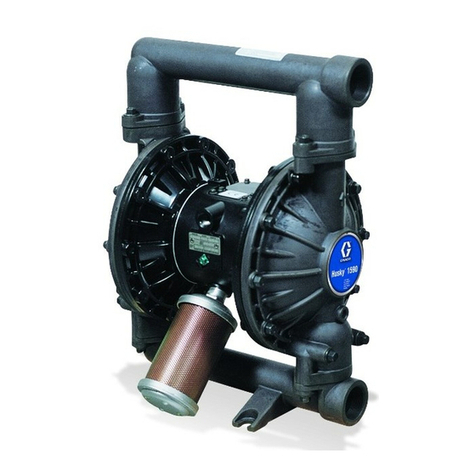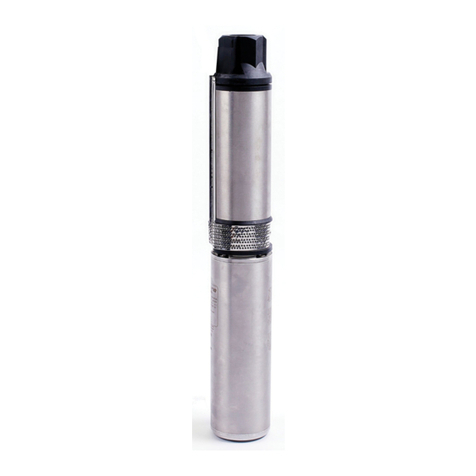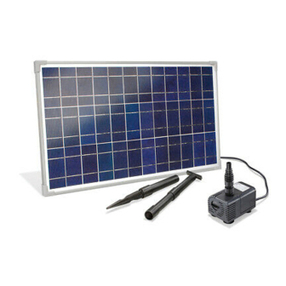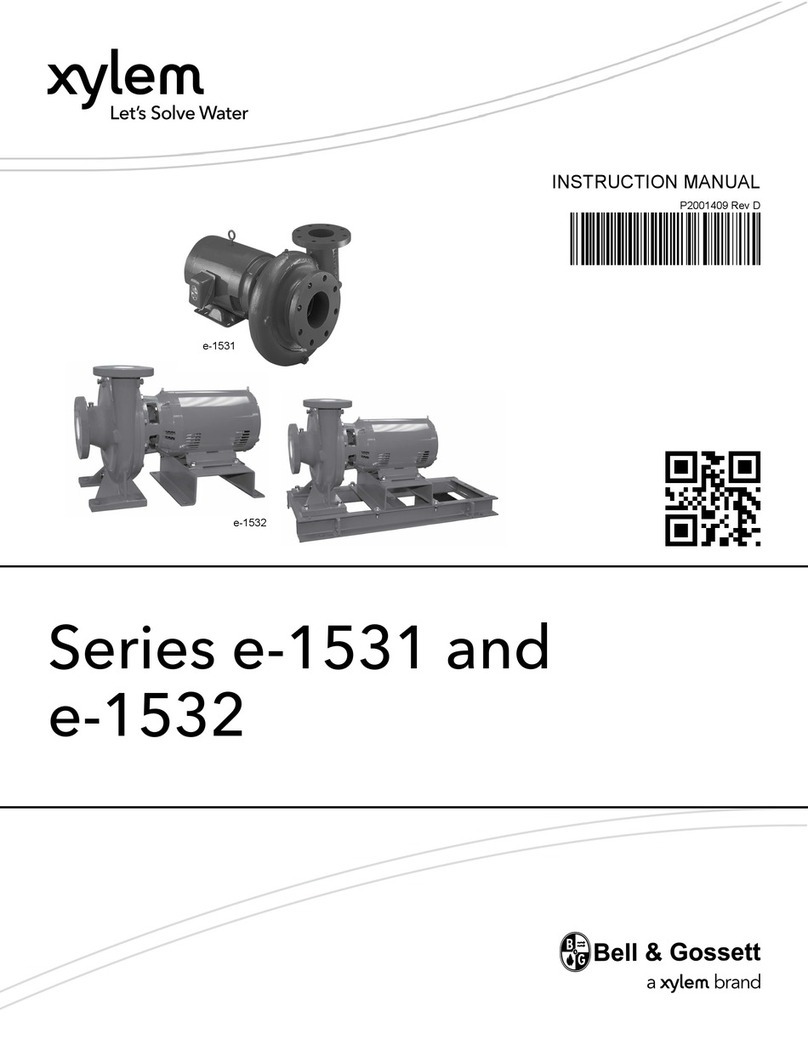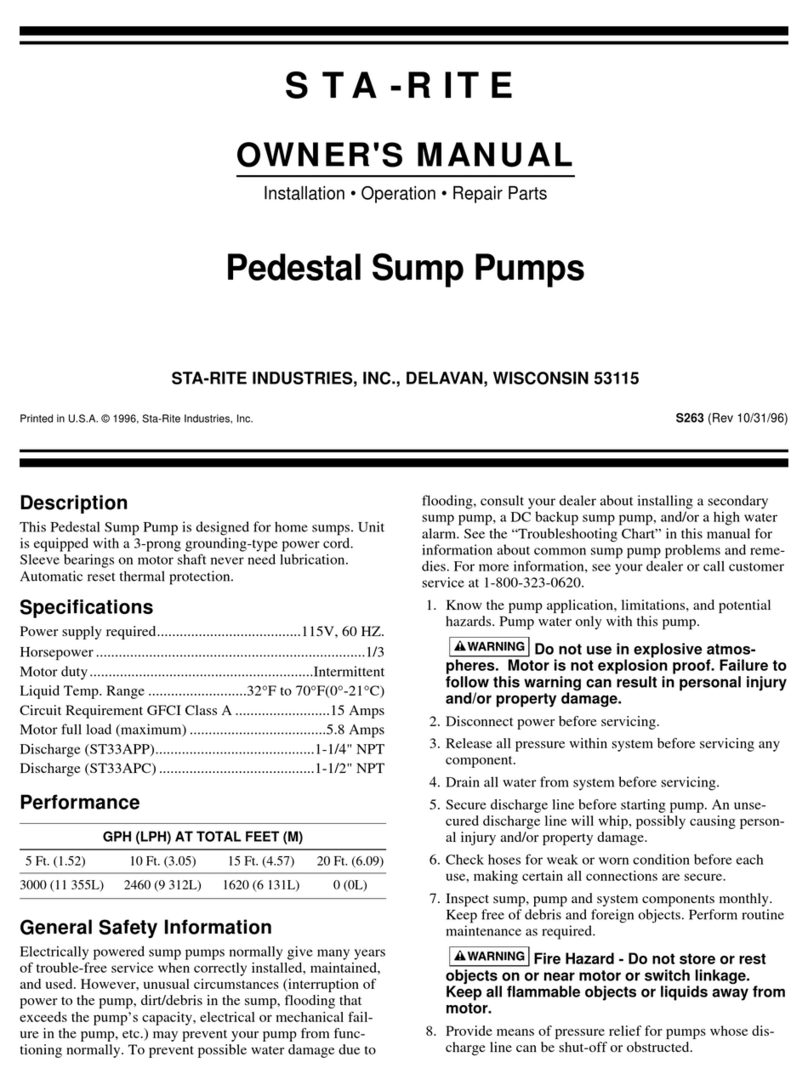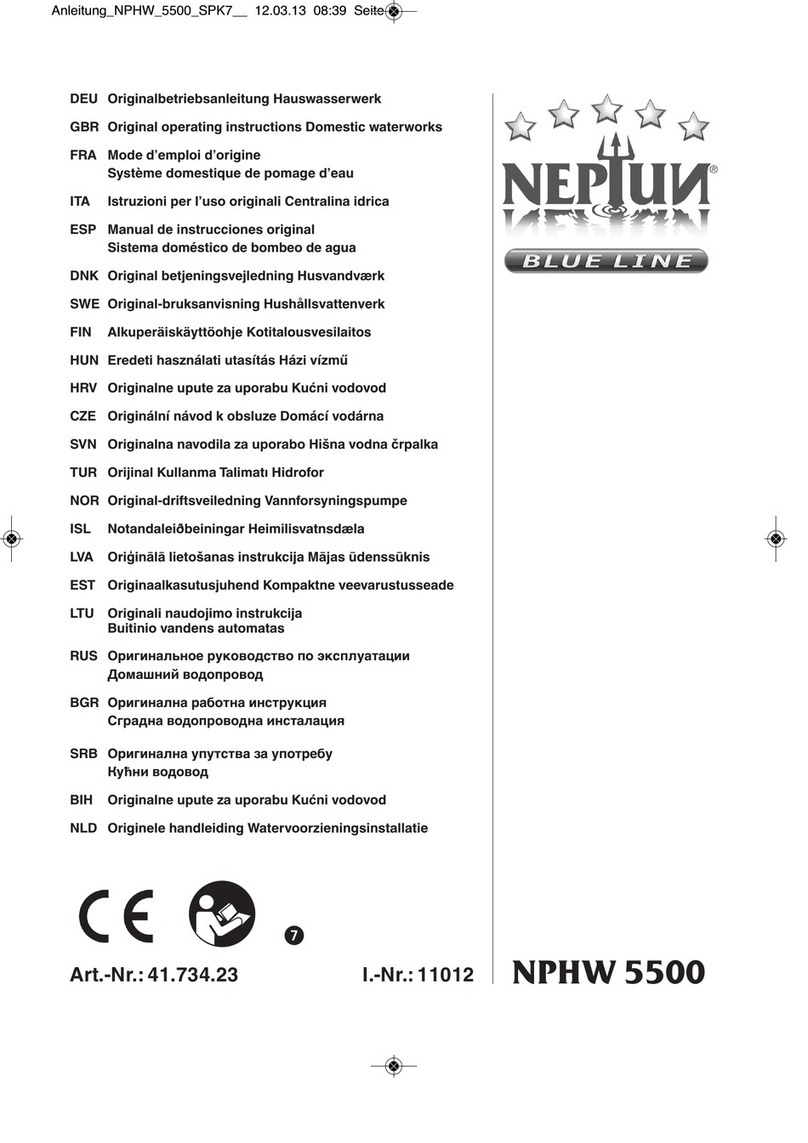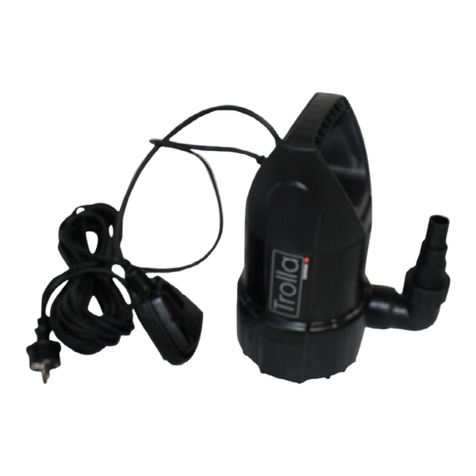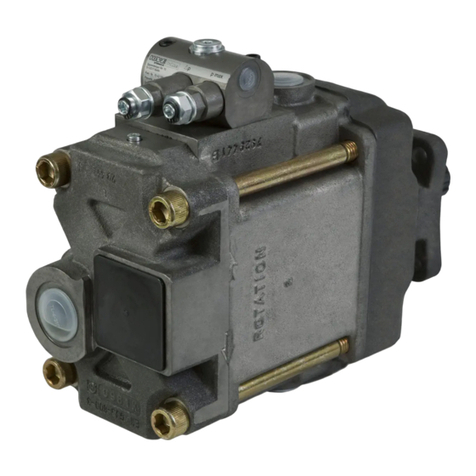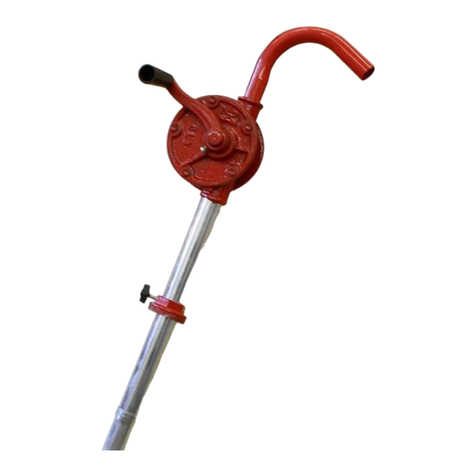
307-928
SAFETY
W
ARNINGS
HIGH
PRESSURE FLUID CAN CAUSE SERIOUS INJUR
Y
. FOR PROFESSIONAL USE ONL
Y.
OBSERVE
ALL W
ARNINGS. Read And Understand All Instruction Manuals Before Operating Equipment.
FLUID INJECTION HAZARD
General
Safety
This
equipment
generates very high fluid pressure. Spray from the spray
gun,
leaks or ruptured components can inject fluid through your skin and
into
your body and
cause extremely serious bodily injury
, including the
need
for amputation. Also, fluid injected or splashed into the eyes or on
the
skin can cause serious damage.
NEVER
point the spray gun at
anyone or at any part of the body
. NEVER
put
hand or fingers over the spray tip. NEVER try to “blow back” paint; this
is
NOT an air spray system.
ALWA
YS have the tip guard in place on
the spray gun when spraying.
ALWAYS
follow the
Pressure Relief Procedure
, right, before
cleaning
or
removing the spray tip or servicing any system equipment.
NEVER try to stop or deflect leaks with your hand or body
.
Be sure equipment safety devices are
operating
properly before each
use.
Medical
Alert––Airless Spray W
ounds
If
any fluid appears
to penetrate your skin, get
EMERGENCY MEDICAL
CARE
A
T
ONCE. DO NOT TREA
T AS A SIMPLE CUT
. T
ell the doctor
exactly
what fluid was injected.
Note
to Physician:
Injection in the skin
is a traumatic injury
.
It is im
-
portant
to treat the injury surgically as soon as possible
. Do
not
delay
treatment to research toxicity
. T
oxicity is a concern with some ex
-
otic
coatings injected directly into the blood stream. Consultation with a
plastic
surgeon or reconstructive hand surgeon may be advisable.
Spray
Gun Safety Devices
Be
sure all spray gun safety devices are operating properly before each
use.
Do not
remove or modify any part of the spray gun; this can cause a
malfunction
and result in serious bodily injury
.
Safety
Latch
Whenever
you stop spraying, even
for a moment, always set the spray
gun
safety latch in the
closed or “safe” position, making the spray gun in
-
operative.
Failure to set the safety latch can result in accidental triggering
of
the spray gun.
Trigger
Guard
Never
operate the spray gun with the trigger guard removed. This guard
helps prevent the gun from triggering accidentally if it is dropped or
bumped.
Diffuser
The
spray gun dif
fuser breaks up spray and reduces the risk of fluid injec
-
tion
when the tip is not installed. Check the dif
fuser operation regularly
.
Follow
the
Pressure Relief Procedure
, below
, then remove the spray
tip.
Aim the spray gun into a grounded metal pail, holding the spray gun
firmly
to the pail. Using the lowest possible pressure,
trigger the spray
gun.
If the fluid emitted is not dif
fused into an irregular
stream, replace the
diffuser
immediately
.
Tip
Guard
ALWAYS
have the tip guard in place on the spray gun while spraying. The
tip
guard alerts you to the fluid injection hazard and
helps reduce,
but
does
not prevent,
the risk of accidentally placing your fingers or any part
of
your body close to the spray tip.
Spray T
ip Safety
Use
extreme caution when cleaning or changing spray tips. If the
spray
tip
clogs
while spraying, engage the spray gun safety latch immediately
.
ALWAYS
follow the
Pressure Relief
Procedure
and then remove the
spray tip to clean it.
NEVER
wipe of
f build-up around the spray tip until pressure is fully re
-
lieved
and the spray gun safety latch is engaged.
Pressure
Relief Procedure
To
reduce the risk of serious bodily injury
, including fluid injection,
splashing
in the eyes or on the skin, or injury from moving parts,
always follow this procedure whenever you shut off the pump,
when
checking or servicing any part of the spray system, when in
-
stalling,
cleaning or changing spray tips, and whenever you stop
spraying.
1. Engage
the spray gun safety latch.
2. Shut
of
f the main power to the heater
, if used. Circulate the
fluid
for
at least 10 minutes to allow it and the heater to cool.
3.
Shut of
f the air to the pump.
4. Close
the bleed-type
master air valve (supplied in your sys
-
tem).
5. Disengage
the spray gun safety latch.
6. Hold a metal part of the spray gun firmly to the side of a
grounded
metal pail, and
trigger the spray gun to relieve pres
-
sure.
7. Engage
the spray gun safety latch.
8. Open
the
drain valve (supplied in your system), having a con
-
tainer
ready to catch the drainage.
9. Leave
the drain valve open until you are ready to spray
again.
If
you suspect that the spray tip or hose is
completely clogged, or
that
pressure has not been fully relieved after following the steps
above,
VER
Y SLOWL
Y loosen the tip guard retaining nut or hose
end coupling and relieve pressure gradually, then loosen com-
pletely.
Now clear the tip or hose.
EQUIPMENT MISUSE HAZARD
General
Safety
Any misuse of the spray equipment or accessories, such as
overpressurizing,
modifying parts, using incompatible chemicals and flu
-
ids, or using worn or damaged parts, can cause them to rupture and result
in
fluid injection, splashing in the eyes or on the skin, or other serious bod
-
ily
injury
, or fire, explosion or property damage.
NEVER
alter or modify any part of this equipment; doing so
could cause it
to
malfunction.
CHECK
all spray equipment regularly and repair or replace worn or dam
-
aged
parts immediately
.
Always
wear protective eyewear
, gloves, clothing and
respirator as rec
-
ommended
by the fluid and solvent manufacturer
.
System
Pressure
The
30:1 ratio President pump
can develop 3000 psi (210 bar) MAXIMUM
WORKING
PRESSURE at 100 psi (7 bar) MAXIMUM INCOMING AIR
PRESSURE.
NEVER exceed 100 psi (7 bar) air pressure to the pump.
Be
sure that all spray equipment and
accessories are rated to withstand
the maximum working pressure of the pump. DO NOT exceed the
maxi
-
mum
working pressure of any component or accessory used in the sys
-
tem.
Fluid
Compatibility
BE
SURE that all fluids and solvents used are chemically compatible with
the
wetted parts shown in the
TECHNICAL DA
TA
on the back page or in
the
separate component manuals. Always read the manufacturer
’s
litera
-
ture
before using fluid or solvent in this pump.

